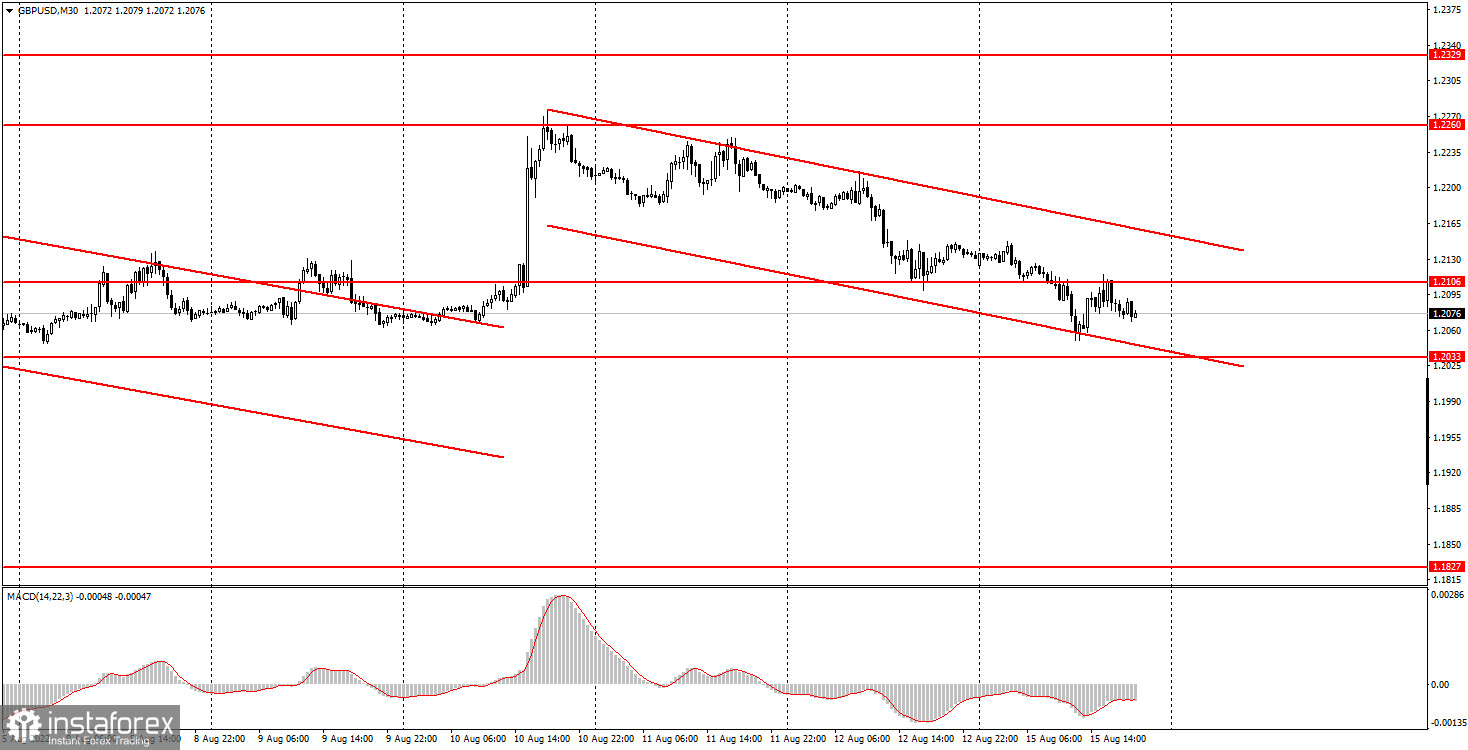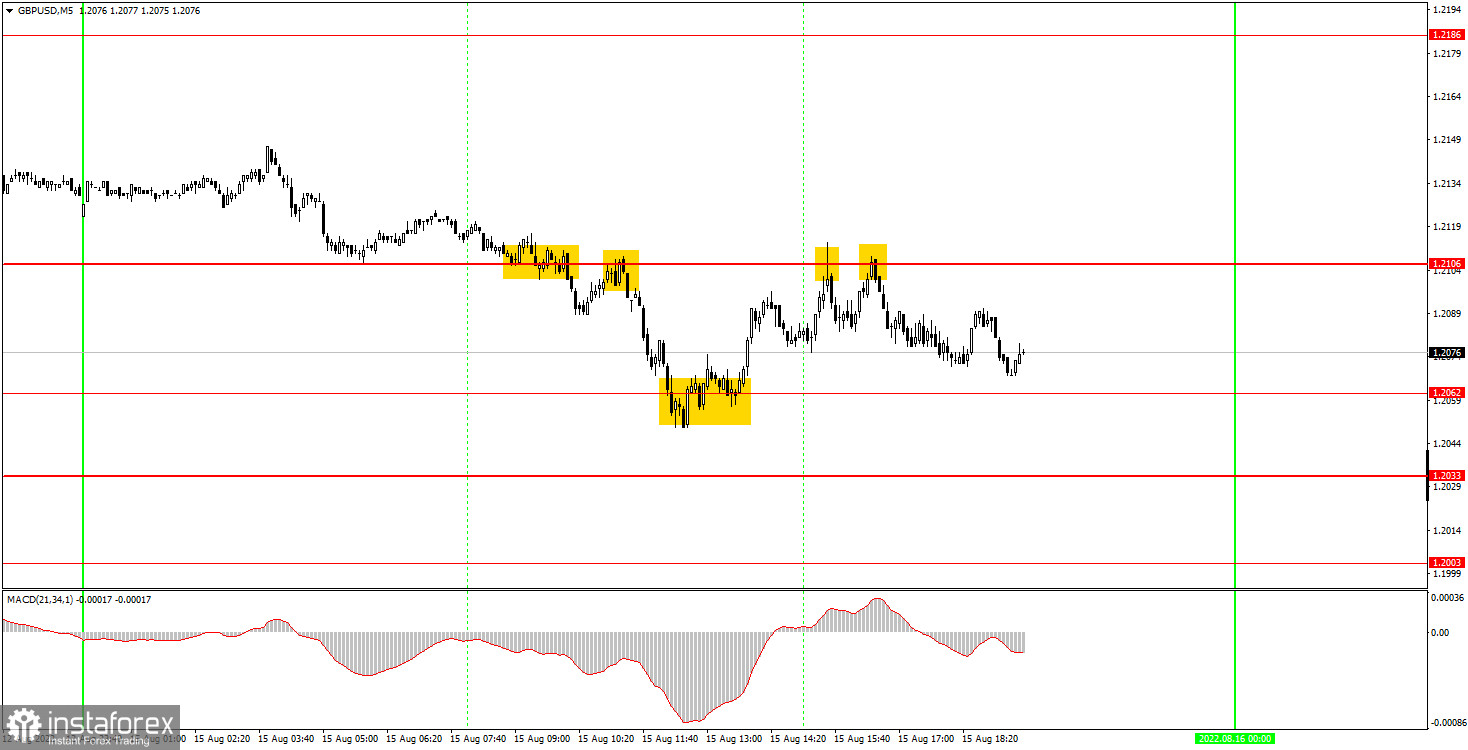Analysis of Monday's deals:
30M chart of the GBP/USD pair

The GBP/USD pair continued its downward movement on Monday. And so confident that we have formed a new downward channel. It is, however, quite narrow, which means that it will be quite easy to get out of it. However, it may help in trading in the next couple of days. There were no important reports in the UK or in the US on Monday either, so the market had nothing to react to today. So much the better, as the new fall in the British currency clearly shows the mood of traders at the moment. And it is again almost the same as that of traders in the euro/dollar pair. That is, the euro and the pound again show a high degree of correlation. We believe that the global downtrend will be renewed as bulls failed to build on their own success last week after the release of the resonant US inflation report. The dollar only fell for a short time, and then turned into growth. And it has been growing for two days, although there were few reasons for this. Or rather, it didn't exist at all. There will be important reports that may affect the movement of the pound/dollar pair this week in the UK, but we believe that they will not fundamentally change the current state of affairs. And now the situation is as follows: after a monthly upward correction (visible on the 24-hour timeframe), both major pairs are clearly going down. Far and for a long time.
5M chart of the GBP/USD pair

The pound/dollar pair moved very well on the 5-minute timeframe on Monday, although the movement was not one-sided, as for the euro/dollar pair. The first two sell signals actually duplicated each other and formed near the level of 1.2106. They should have been worked out with a short position, after which the pair dropped to the level of 1.2062 and did not work it out very accurately. Nevertheless, a buy signal was formed around this level, no matter how you look at it. A short position should have been closed in profit of about 28 points and a long position immediately opened. A few hours later, the price returned to the level of 1.2106, from which it rebounded two more times, so these signals should also be worked out with a short position. The price managed to go down another 15 points until the evening, and the long position managed to earn about 20 points. As a result, the total profit on three transactions should have been about 65 points.
How to trade on Tuesday:
The GBP/USD pair has formed a clear downward trend on the 30-minute time frame, which may continue this week. The channel is narrow enough that it can transform. In general, we believe that the pound will continue to move down in any case, as bulls over the past month have again shown their passivity. On the 5-minute TF on Tuesday, it is recommended to trade at the levels of 1.1967, 1.2003, 1.2033, 1.2062, 1.2106, 1.2186-1.2205, 1.2245-1.2260. When the price passes after opening a deal in the right direction for 20 points, Stop Loss should be set to breakeven. Several interesting publications are scheduled for Tuesday in the UK. In particular, the unemployment rate and average wages. Both of these reports are unlikely to provoke a serious market reaction, but they can affect the pair's movement. Only minor reports on industrial production in America.
Basic rules of the trading system:
1) The signal strength is calculated by the time it took to form the signal (bounce or overcome the level). The less time it took, the stronger the signal.
2) If two or more deals were opened near a certain level based on false signals (which did not trigger Take Profit or the nearest target level), then all subsequent signals from this level should be ignored.
3) In a flat, any pair can form a lot of false signals or not form them at all. But in any case, at the first signs of a flat, it is better to stop trading.
4) Trade deals are opened in the time period between the beginning of the European session and until the middle of the US one, when all deals must be closed manually.
5) On the 30-minute TF, using signals from the MACD indicator, you can trade only if there is good volatility and a trend, which is confirmed by a trend line or a trend channel.
6) If two levels are located too close to each other (from 5 to 15 points), then they should be considered as an area of support or resistance.
On the chart:
Support and Resistance Levels are the Levels that serve as targets when buying or selling the pair. You can place Take Profit near these levels.
Red lines are the channels or trend lines that display the current trend and show in which direction it is better to trade now.
The MACD indicator (14,22,3) consists of a histogram and a signal line. When they cross, this is a signal to enter the market. It is recommended to use this indicator in combination with trend lines (channels and trend lines).
Important speeches and reports (always contained in the news calendar) can greatly influence the movement of a currency pair. Therefore, during their exit, it is recommended to trade as carefully as possible or exit the market in order to avoid a sharp price reversal against the previous movement.
Beginners on Forex should remember that not every single trade has to be profitable. The development of a clear strategy and money management are the key to success in trading over a long period of time.
 English
English 
 Русский
Русский Bahasa Indonesia
Bahasa Indonesia Bahasa Malay
Bahasa Malay ไทย
ไทย Español
Español Deutsch
Deutsch Български
Български Français
Français Tiếng Việt
Tiếng Việt 中文
中文 বাংলা
বাংলা हिन्दी
हिन्दी Čeština
Čeština Українська
Українська Română
Română

